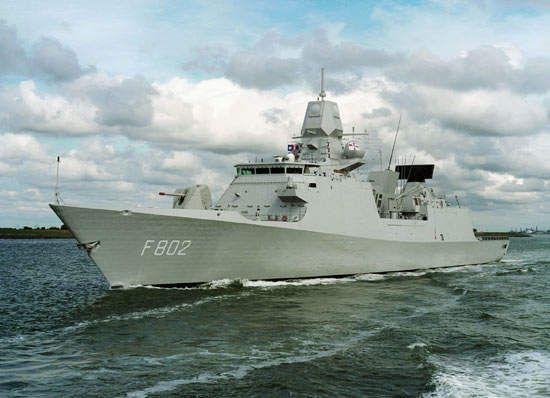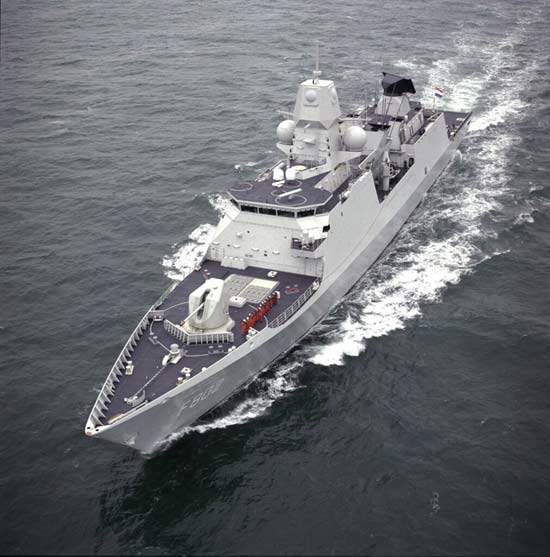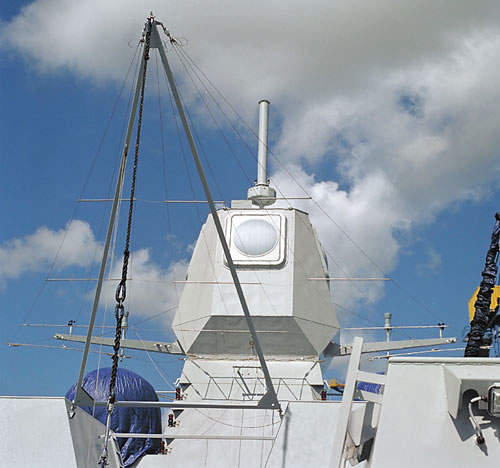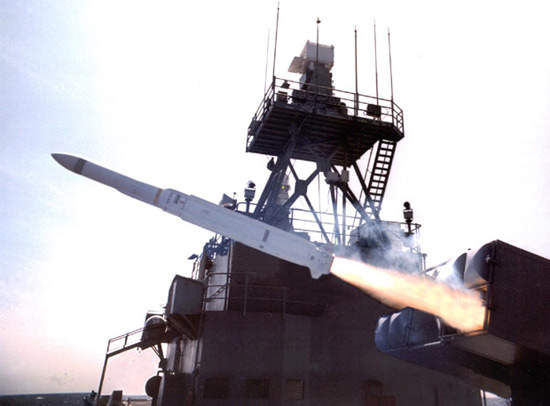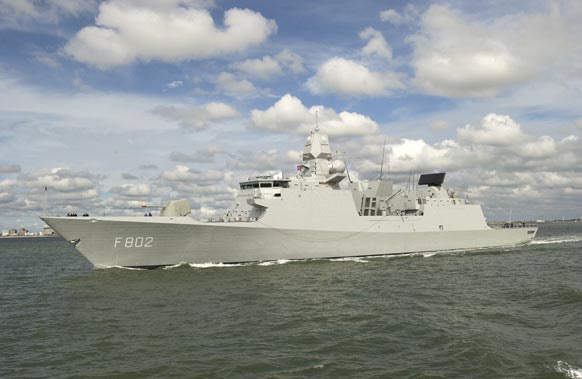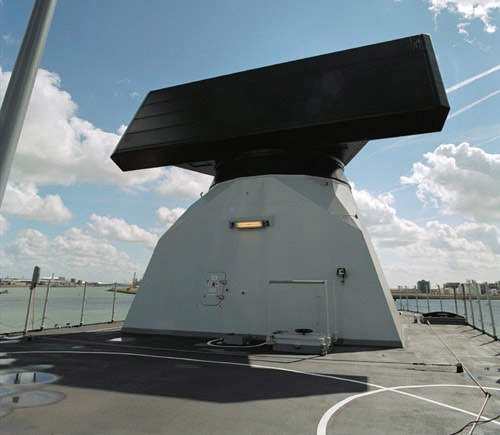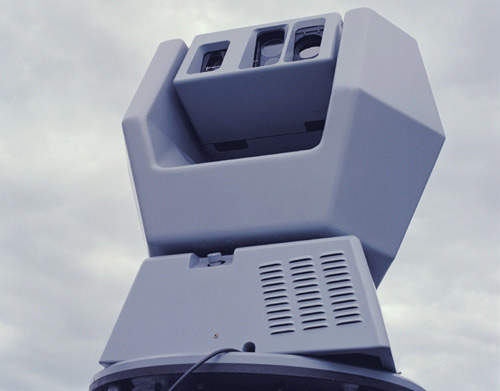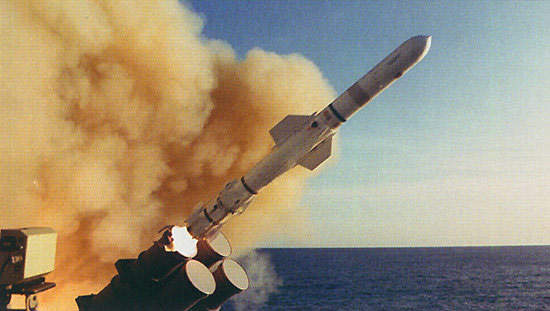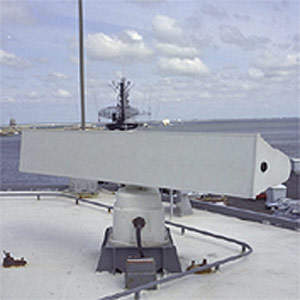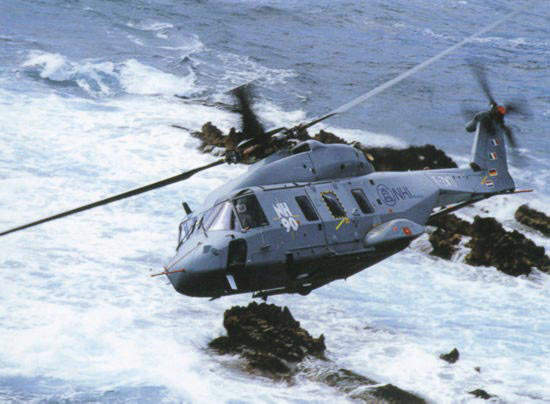Royal Schelde has built four De Zeven Provincien Class guided missile carrying fast frigates for the Royal Netherlands Navy. The air defence and command (LCF) frigates were built at Royal Schelde’s Flushing shipyard. They replaced Tromp Class and Jacob van Heesmarck Class frigates.
The first of class, HNLMS De Zeven Provincien (F802), was commissioned in April 2002. HNLMS Tromp (F803) was commissioned in March 2003, HNLMS De Ruyter (F804) in April 2004 and HNLMS Evertsen (F805) in June 2005.
In December 2003, HNLMS De Zeven Provincien became the first vessel to successfully fire the evolved Sea Sparrow missile (ESSM) and Standard missile SM2-MR block IIIA using interrupted and continuous wave illumination and X-band uplinks. Both missiles were controlled by the APAR radar.
In December 2006, HNLMS Tromp participated in tactical ballistic missile defence (TBMD) tests with the US Navy. The ship, fitted with a Thales SMART-L radar with a new extended long-range mode, was able to detect and track targets representing tactical ballistic missiles.
In November 2008, HNLMS De Zeven Provincien completed its first test launches of the Boeing Harpoon missile, off the coast of Virginia, USA.
Trilateral frigate agreement
The Netherlands, Germany and Spain set up the trilateral frigate agreement for the national construction of frigates. In addition to the De Zeven Provincien, the F100 (Alvaro de Bazan) is being built in Spain by Navantia and the F124 (Sachsen) built in Germany by ARGE F124 (Blohme and Voss, HDW and Thyssen Nordseewerke). The cooperation extends to the ship platform and not to the systems.
Stealth-orientated frigate design
The design of the ship incorporates stealth features with an emphasis on the reduction of radar cross section, infrared, acoustic, electrical and magnetic signatures.
Watertight compartments, insulation, redundancy of vital systems, power distribution, and routing, blast and fragmentation retaining structures provide a very high level of survivability against missile attack and fire hazards. For nuclear chemical and biological warfare protection the ship is subdivided into two gas citadels and a sub citadel.
SEWACO XI combat data command system
The ship is equipped with the SEWACO XI combat data system developed by Thales Naval Nederland. The RNIN’s Centre for the Automation of Weapon and Command Systems (CAWCS) has developed the software. The system will use asynchronous transfer mode (ATM) network architecture.
The Rohde & Schwarz communications suite includes secure voice and data satellite communications, Link 11 and Link 16.
ESSM and SM2-MR block IIIA surface-to-air missile systems
The long-range surface-to-air missile system is the evolved Sea Sparrow missile (ESSM) developed by an international team led by Raytheon Missile Systems that has semi-active radar guidance with tail control motor to improve range, speed and manoeuvrability.
The ship’s medium-range anti-air missile is the Raytheon Standard missile SM2-MR block IIIA. SM-2MR has a range of 70km, a speed of Mach 2.5 and has semi-active radar seeker and an Aegis radio command link.
Both ESSM and SM2 are fired from a 40-cell mk41 vertical launch system (VLS). The five octuple launchers are installed with the caps almost flush with the surface of the bow deck behind the main gun.
The Boeing Harpoon surface-to-surface missile system is installed on the raised deck immediately behind the main mast.
Harpoon is a medium-range missile with a range of 120km, a 220kg warhead and active radar terminal guidance.
In November 2005, RNLN announced plans to acquire 30 Tomahawk block IV (Tactical Tomahawk) land attack missiles were approved. However in May 2007, the planned procurement was cancelled.
Guns
The ship’s main gun on the bow deck is a 127mm / 54-calibre Oto Melara gun. Two Thales Naval Nederland Goalkeeper close-in weapon systems are installed, one on the raised deck in front of the main mast and one facing the stern on the raised deck overlooking the helicopter landing deck. Goalkeeper’s Gatling principle 30mm gun provides a maximum firing rate of 4,200 rounds a minute with a range of 1,500m.
Two close-in Oerlikon 20mm machine guns are installed, one to port and one to starboard of the main mast.
Twin mk32 mod 9 323mm torpedo launchers
Two mk32 mod 9 323mm twin torpedo launchers are fitted one on each side of the ship at about two-thirds the length of the ship from the bow. 24 mk46 mod 5 torpedoes are stored in the ship’s magazine.
De Zeven Provincien Class countermeasures
The frigates are fitted with the Thales Defence Sabre integrated electronic warfare system which includes a 0.5GHz to 18GHz electronic support measures (ESM) system and a 7.5GHz to 18GHz active phased-array electronic countermeasures (ECM) system.
The ship has four launchers for the SRBOC (super rapid blooming off-board countermeasures) decoy system from Lockheed Martin Sippican. The towed torpedo decoy is the Argon ST (formerly Sensytech) AN/SLQ-25 Nixie.
Helicopters and flight deck
There is a 27m flight deck at the stern of the ship and a hangar with accommodation for a single helicopter such as the AgustaWestland Lynx of the Royal Netherlands Navy, or the 10t NH90 naval helicopter which entered service in 2010.
The deck is fitted with the DCN Samahe helicopter handling system which allows deployment and recovery of the Lynx or NH90 helicopter in high sea states. The ship’s helicopter direction system is the VESTA.
Sensor systems
The ship’s radar suite was supplied by Thales Naval Nederland. The Smart-L three dimensional radar operating in D band provides air search. APAR (active phased array radar) provides air and surface search and weapon fire control. APAR is a multi-function radar operating at X-band. It provides target search and tracking and guidance for the Standard missile 2. The Scout LPI (low probability of intercept) radar operating at I band provides surface search. There is also a mkXII identification friend or foe (IFF) radar.
In April 2006, the Dutch government placed an order for four Thales Naval Nederland Sirius LR-IRST long-range dual-band infrared search and track systems for the vessels. Sirius was installed on top of the mast tower. The system provides horizon search capability against sea-skimming missiles. Thales Mirador electro-optic surface surveillance system is also fitted.
In June 2012, Thales Nederland was awarded a contract to modify four SMART-L volume search radars aboard the frigates. The new radar will detect and track the trajectory of ballistic missiles.
The ship’s sonar system is the Atlas Elektronik DSQS-24C hull-mounted search and attack sonar.
CODOG propulsion system and engines
The ship’s combined diesel or gas (CODOG) propulsion system has two independent propulsion lines. The two Rolls-Royce Spey SM1C gas turbine engines each provide 18.5MW. Two cruise diesel engines, Stork-Wartsila 16 V26, provide 8.4MW.
The two gearboxes are installed in a separate transmission room. The ship has two controllable-pitch propellers and two rudders with rudder roll stabilisation.
The maximum ship speed is 30kt and the cruise speed is 18kt. The range is 5,000 miles at 18kt.
The Global Naval Surface Combatants and Warfare Systems Market 2011-2021
This project forms part of our recent analysis and forecasts of the global naval surface combatants and warfare systems market available from our business information platform Strategic Defence Intelligence. For more information click here or contact us: EMEA: +44 20 7936 6783; Americas: +1 415 439 4914; Asia Pacific: +61 2 9947 9709 or via email.

